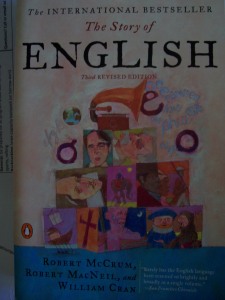Hooray! I’ve finished with my last final and after tonight I will have no more classes to attend. 😀 In less than two weeks, I will officially be a college graduate! Now, barring any unforeseen circumstances I should be able to resume my regular posting schedule next week. 😀 In the meantime, I thought it would be fun to share what my final paper for my Nature of the English Language class ended up being. Lol! This class was awesome! 😀
Here’s the basics of the assignment:
Your assignment is that of an anthropologist of the English language. You’ll observe a “tribe” of your choice and report to the Drury University Anthropological Society of your findings in a letter of about 1000 words. What are the origins of this tribe? Where is their habitat? What are their traditions or the nature of their culture? How does this “tribe” of your choice use specific words, phrases, language to communicate? Pick a tribe you’re interested in “studying.” Here are some examples: teenagers, servers, students, hairdressers, convenience store workers, men, women, couponers, mothers, football players, NASCAR fans, co-workers. It doesn’t matter. Just observe your chosen tribe and its use of language. Tribes have their own vocabularies and ways of speaking which make them a cohesive, exclusive group. Their use of language cements their bond to each other and excludes others preserving the integrity of the “tribe.”
Now you know there is no Drury University Anthropological Society, but it gives you an audience. You can have fun with this, but you will be using your skills of observation and what you’ve learned about the English language. If you want to use some outside sources to support your “research” that’s fine. Just be sure to cite those sources in your text and include a Works Cited page. No Wikipedia.
Fun, right?!
AND here’s how I chose to “play” with it:
To the Board and Chair of the Drury Anthropological Society:
For the previous decade, I have been deeply interested in the dealings of the nutrition community. This tribe is of substantial size and includes people from a wide range of educational and social backgrounds, but they are united by common terminology and manners. Interestingly, their language and customs often exclude the majority of people because the jargon they use tends to be incomprehensible to outsiders. As I have gleaned more information about their language, I have begun to understand more of their speech. In the process of my research, I found the story of their origin of particular interest because it reaches far back to ancient Greece and Hippocrates’ teachings. It is well-known in the nutrition community that Hippocrates is the “father of medicine” and his famous statement of “Let thy food be thy medicine and medicine be thy food” is often quoted. Over the centuries, herbalists and doctors have used Hippocrates as a standard for determining the “do”s and “don’t”s of proper fueling for the human body through diet.
The nutrition community firmly believes that the food people eat has the power to heal or harm the human body. Although some are certainly more outspoken in this belief than others. Over the years, I have encountered members of this community in a variety of habitats. They can be found in ordinary places like grocery stores and doctor’s offices, but they can also be found at farmer’s markets and health food stores. In addition to the aforementioned locations, members of the nutrition community can be found working jobs in hospitals, weight-loss clinics, fitness centers, holistic retreats, chiropractic offices, massage therapy spas, and a whole host of other business settings. For some in the community, their job directly relates to nutrition, while for others nutrition is simply a passion. No matter the individual story though, I’ve found they all can speak with one another without difficulty whatsoever. Over time, I have found myself to not only understand the jargon, but to assimilate it into my own speech as well.
Because I’ve heard many of their words and phrases numerous times over the years, they’ve become commonplace to me and I forget that once they were foreign. Numerous times in the past few years I’ve gotten looks of confusion from the person I’m talking with and it always takes me a minute to ascertain what has caused the confusion. I think I may now be considered a community member at this point since nutrition has become a passion of mine. As I consider the traditions and habits of this tribe, I see where I align with them. Traditionally speaking, the members of this tribe put into practice what they preach. Health and vitality have the utmost precedence for them. Also, one habit they all tend to have in common is perpetual learning. Research, testing, learning new terms, and staying on top of new developments is paramount to all other habits for this community. Once a person ceases the acquisition of knowledge that person soon falls behind the others and cannot participate in conversation as much because the jargon the others use has become incomprehensible. For this reason, I liken the nutrition community to the English language itself; dynamic and ever-changing. Often the currents of innovation and development become a raging river and it takes years of study to assimilate the knowledge. The tide of which feeds their vocabulary.
Often, I’ve wondered at the exclusivity of their language and the why behind it. After careful consideration, I have concluded that much of that stems from the fact that the nutrition community was born out of the scientific community. While these two haven’t completely divorced from one another, there does seem to be a separation based on the focus of studies. Even still, classes such as Human Anatomy and Physiology overlap with Human Nutrition which allows for some cross-cultural communication. Since the nutrition community began and has grown up around the scientific jargon, it’s simply ingrained in their vocabulary. As I read news about health and nutrition, I find it encouraging how much of the terminology is filtering into all areas of society, though. I’m hopeful that as more people begin to understand the workings of their body and the affects which nutrition, whether poor or excellent, has upon their health they’ll find it easier to make more educated food choices. Terminology is key to helping the masses comprehend what the nutrition community is talking about though.
Breaking down what they say will help aid in understanding, but that can be difficult. An interesting aspect to the terminology employed by the nutrition community is the fact that a lot of their “words” are actually acronyms, which are words formed from the initial letters of other words. For instance, BMI stands for Body Mass Index, which is a method of calculating a person’s “fatness” by using their height and weight. This is the way doctors and others in the health profession determine what weight-class a person falls into (i.e. underweight, normal, overweight, obese, or extremely obese). These aren’t the only obstacles. Words and phrases like “empty calories”, macronutrients, “free radicals”, and antioxidants frequently stump the uninitiated, though these are making more regular appearances in articles that “outsiders” read. However, some terms are simply more complex than others, like bio-availability. What does that mean? In simple terms, it’s used to describe the amount of a given nutrient that can be absorbed and used by the cells of the body and it can be affected by the way a food is processed, fiber in diet, and the health of a person’s digestive system (namely the large intestine since that is where the majority of nutrients are absorbed into the body for use).
It takes an inquisitive mind to even wish to embark on the journey of understanding this tribe, but I can assure you it is enriching and not something to look back upon with regret. Perhaps it helped that I have always been intrigued by the curious workings of the human body; how it uses food to provide energy, what causes breakdowns, and how it heals. Because of the ever-changing nature of this tribe, I fully intend to keep learning from them and their ways as the nutrition community has a lot of important concepts to teach. I’ve already learned so much and have found the learning to be great fun.
These are my findings thus far, I do hope this has been as enlightening and intriguing for you as it has for me. Always learn and be eager to share your knowledge with others because oftentimes what we love others will too.
Sincerely,
Denise Peachey
Glossary:
~ antioxidants= these are the neutralizers of the free radicals. (Vitamins C and E are prime examples, that’s why doctor’s often tell smokers to take a vitamin C supplement as it helps to counter the negative effects of smoking.)
~ empty calories= come from “foods” that are higher in calories than in nutrients and are often less filling. Also, these are often immediately stored as fat in the body.
~ free radicals= these are “loose” hydrogen atoms floating around in the body and are damaging to body tissues and organs because of their oxidizing effects (similar to the process of metal rusting).
~ macronutrients= these are the large parts of the human diet: Carbohydrates, Fats (also called Lipids), Protein, and Water. Also, to add to the uninitiated person’s confusion, Carbs, Fats, and Proteins can be further divided into subcategories or types. (Vitamins and minerals are considered micronutrients.)
Note: An excellent textbook for spelling nutrition all out step-by-step and in lessons that build upon one another is Nutrition: Concepts and Controversies by Sizer and Whitney. It’s in its 13th edition since 1979 as it is updated and revised every three years.


